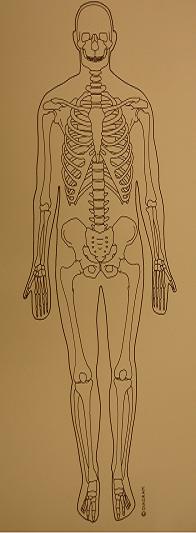Human anatomy: Difference between revisions
imported>David Hume mNo edit summary |
imported>David Hume |
||
| Line 43: | Line 43: | ||
==Anatomical Orientation== | ==Anatomical Orientation== | ||
Anatomy may involve dissecting or cutting up the body (cadaver). Most anatomy courses incorporate theoretical and practical training. A firm understanding of anatomical orientation is essential in learning, understanding, and communicating anatomical topics. Anatomical planes are imaginary planes through the body used to describe the orientation of a section. A person in the standard anatomical position is standing up straight with the arms hanging at the sides with the palms of the hands facing in the same direction as the face. | Anatomy may involve dissecting or cutting up the body (cadaver). Most anatomy courses incorporate theoretical and practical training. A firm understanding of anatomical orientation is essential in learning, understanding, and communicating anatomical topics. Anatomical planes are imaginary planes through the body used to describe the orientation of a section. A person in the standard anatomical position is standing up straight with the arms hanging at the sides and with the palms of the hands facing in the same direction as the face. | ||
[[Image:DSC03012a.JPG|right|frame|Anatomical Position - wonderful opportunity for a photoshop wizard here to put in a nicer pic. Yes, this one is copyrighted but free for educational use]] | [[Image:DSC03012a.JPG|right|frame|Anatomical Position - wonderful opportunity for a photoshop wizard here to put in a nicer pic. Yes, this one is copyrighted but free for educational use]] | ||
| Line 51: | Line 51: | ||
**sagittal | **sagittal | ||
**coronal/frontal | **coronal/frontal | ||
** | **transverse/cross | ||
**oblique | **oblique | ||
Revision as of 15:09, 18 February 2007
Parent article - anatomy
Definition
Human Anatomy is the branch of anatomy devoted to the structure of the human body. It cannot be totally divorced from physiology because structure and function go hand in hand.
Approaches to Anatomy
The study of anatomy can be divided up either by function, e.g. the digestive system or by structure and location, e.g. the eye and the head. Many branches of anatomy, e.g. functional anatomy, overlap with physiology. Branches of anatomy include comparative anatomy, functional anatomy, developmental anatomy, pathological anatomy, gross anatomy, microanatomy, histology, and cytology.
The Major Systems of the Human Body
- Skeletal System
- Lymphatic System
- Integumentary System
- Cardiovascular System
- Muscular System
- Endocrine System
- Nervous System
- Respiratory System
- Reproductive System
- Excretory System
- Digestive System
- Immune System
Traditionally there were only eleven systems but as knowledge has grown, the Immune System, sometimes called the Lymphoid System, has been added because of its great importance, even though it is closely allied to the Lymphatic System. The Excretory Sytem is also referred to as the Urinary System.
Memory Aids for the Systems of the Human Body
A mnemonic for the traditional eleven systems is:
- SLIC MEN R RED
For all twelve, you might use:
- RELICS REMIND
- Reproductive
- Excretory
- Lymphatic
- Immune
- Cardiovascular
- Skeletal
- Respiratory
- Endocrine
- Muscular
- Integumentary
- Nervous
- Digestive
Anatomical Orientation
Anatomy may involve dissecting or cutting up the body (cadaver). Most anatomy courses incorporate theoretical and practical training. A firm understanding of anatomical orientation is essential in learning, understanding, and communicating anatomical topics. Anatomical planes are imaginary planes through the body used to describe the orientation of a section. A person in the standard anatomical position is standing up straight with the arms hanging at the sides and with the palms of the hands facing in the same direction as the face.
- Planes and sections
- median
- sagittal
- coronal/frontal
- transverse/cross
- oblique
- Terms of position and direction
- cranial/superior/rostral
- caudal/inferior
- anterior/ventral
- posterior/dorsal
- medial
- lateral
- proxmial
- distal
- superficial
- deep
- ipsilateral
- contralateral
The History of Anatomy
Learning Anatomy
Anatomy is thoroughly studied in medical school in through lectures, textbooks, atlases (illustrative and photographic), dissection of cadavers, models, demonstrations, videos, and now the Internet.
Cadaver shortage
Reference Books
- Gray's Anatomy – Henry Gray et al.
- The Anatomy Coloring Book – Wynn Kapit / Lawrence M. Elson
- McMinn's Colour Atlas of Human Anatomy – P.H. Abrahams R.T. Hutchings S.C. Marks Jr
- Netter - Atlas of Human Anatomy
- Color Atlas of Anatomy - Rohen / Yokochi / Lütjen-Drecoll
- Imaging Atlas of Human Anatomy - Jamie Weir / Peter H Abrahams
- Essential Clinical Anatomy - Moore / Agur
- Atlas of Clinical Gross Anatomy - Kenneth Moses / John Banks / Pedro Nava / Darrell Petersen
Reference Video Atlases
Acland's DVD Atlas of Human Anatomy, Set of Six DVDs
Reference Links
- http://www.bartleby.com/107/ - Gray's Anatomy – Henry Gray et al. (20th ed. 1918)(has annoying pop behinds)
- http://www.netanatomy.com
- http://msjensen.education.umn.edu/Webanatomy/
- e-Anatomy - Interactive atlas of whole human body cross-sectional anatomy.
